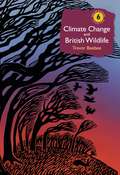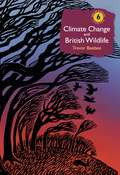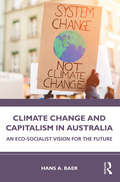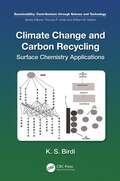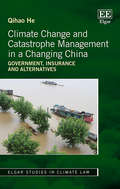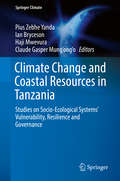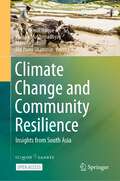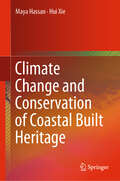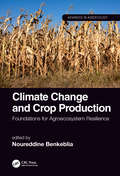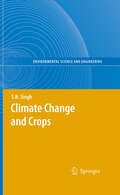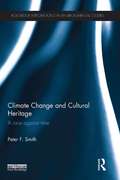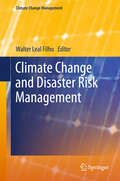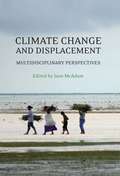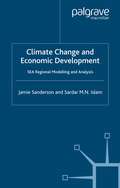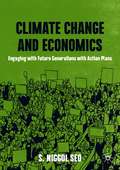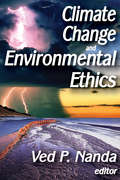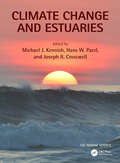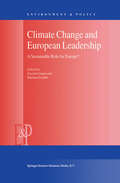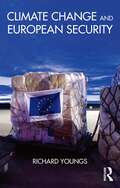- Table View
- List View
Climate Change and British Wildlife (British Wildlife Collection)
by Trevor Beebee“Fascinating but frightening, compelling and concerning … this book brings together all you need to know about how the climate is impacting wildlife.”CHRIS PACKHAMThere is no escaping the fact that the British climate is changing, and our wildlife is changing with it. In this remarkable account, Trevor Beebee examines the story so far for our plant, fungi and animal species. Warmer and wetter winters, combined with longer summers, have worked to the advantage of plants such as the rare Lady Orchid,and a whole range of insects. The UK is also hosting new arrivals that come in on the wing. But there is adversity, too. Alpine plants and seabirds – particularly Kittiwakes – are suffering declines as our countryside warms. Given the evidence so far, can we predict what the future holds for our British ecosystems?
Climate Change and British Wildlife (British Wildlife Collection)
by Trevor Beebee“Fascinating but frightening, compelling and concerning … this book brings together all you need to know about how the climate is impacting wildlife.”CHRIS PACKHAMThere is no escaping the fact that the British climate is changing, and our wildlife is changing with it. In this remarkable account, Trevor Beebee examines the story so far for our plant, fungi and animal species. Warmer and wetter winters, combined with longer summers, have worked to the advantage of plants such as the rare Lady Orchid,and a whole range of insects. The UK is also hosting new arrivals that come in on the wing. But there is adversity, too. Alpine plants and seabirds – particularly Kittiwakes – are suffering declines as our countryside warms. Given the evidence so far, can we predict what the future holds for our British ecosystems?
Climate Change and Capitalism in Australia: An Eco-Socialist Vision for the Future
by Hans A. BaerRecognizing that climate politics has been an increasingly contentious and heated topic in Australia over the past two decades, this book examines Australian capitalism as a driver of climate change and the nexus between the corporations and Coalition and Australian Labor parties. As a highly developed country, Australia is punching above its weight in terms of contributing to greenhouse gas emissions despite rising temperatures, droughts, water shortages and raging bushfires, storm surges and flooding, and the bleaching of the Great Barrier Reef. Drawing upon both archival and ethnographic research, Hans Baer examines Australian climate politics at the margins, namely the Greens, the labour union, the environmental NGOs, and the grass-roots climate movement. Adopting a climate justice perspective which calls for "system change, not climate change" as opposed to the conventional approach of seeking to mitigate emissions through market mechanisms and techno-fixes, particularly renewable energy sources, this book posits system-challenging transitional steps to shift Australia toward an eco-socialist vision in keeping with a burgeoning global socio-ecological revolution. Accessibly written and including an interview with renowned comedian and climate activist Rod Quantock OAM, this book is essential reading for academics, students and general readers with an interest in climate change and climate activism.
Climate Change and Capitalism in Australia: An Eco-Socialist Vision for the Future
by Hans A. BaerRecognizing that climate politics has been an increasingly contentious and heated topic in Australia over the past two decades, this book examines Australian capitalism as a driver of climate change and the nexus between the corporations and Coalition and Australian Labor parties. As a highly developed country, Australia is punching above its weight in terms of contributing to greenhouse gas emissions despite rising temperatures, droughts, water shortages and raging bushfires, storm surges and flooding, and the bleaching of the Great Barrier Reef. Drawing upon both archival and ethnographic research, Hans Baer examines Australian climate politics at the margins, namely the Greens, the labour union, the environmental NGOs, and the grass-roots climate movement. Adopting a climate justice perspective which calls for "system change, not climate change" as opposed to the conventional approach of seeking to mitigate emissions through market mechanisms and techno-fixes, particularly renewable energy sources, this book posits system-challenging transitional steps to shift Australia toward an eco-socialist vision in keeping with a burgeoning global socio-ecological revolution. Accessibly written and including an interview with renowned comedian and climate activist Rod Quantock OAM, this book is essential reading for academics, students and general readers with an interest in climate change and climate activism.
Climate Change and Carbon Recycling: Surface Chemistry Applications (ISSN)
by K. S. BirdiClimate Change and Carbon Recycling: Surface Chemistry Applications describes the application of surface chemistry methods for carbon capture and recycling in relation to climate change and atmospheric CO2 levels. The text is suitable for online education, with both basic and educational descriptions of the climate change process and carbon recycling methods like the adsorption and absorption of CO2 on solids. This book leads to a better understanding of a complex phenomenon and highlight the importance of CO2 capture and sequestration for the future to enable the utilization of fossil fuels without contributing to atmospheric greenhouse gases.Features This unique volume specifically highlights the surface chemistry aspects of carbon capture and recycling (CCR) Fills the need for an online textbook edition, which provides a basic and educational description of the climate change process and carbon capture/recycling Describes the application of surface chemistry methods for carbon capture and recycling, such as adsorption/absorption of CO2 Discusses the importance of recycling in reducing and controlling the concentration of carbon dioxide in the air (420 ppm: 0.042%) Describes the importance of the technology related to carbon capture/recycling and sequestration (CCS) from fossil fuel energy plants as a means of CO2 control
Climate Change and Carbon Recycling: Surface Chemistry Applications (ISSN)
by K. S. BirdiClimate Change and Carbon Recycling: Surface Chemistry Applications describes the application of surface chemistry methods for carbon capture and recycling in relation to climate change and atmospheric CO2 levels. The text is suitable for online education, with both basic and educational descriptions of the climate change process and carbon recycling methods like the adsorption and absorption of CO2 on solids. This book leads to a better understanding of a complex phenomenon and highlight the importance of CO2 capture and sequestration for the future to enable the utilization of fossil fuels without contributing to atmospheric greenhouse gases.Features This unique volume specifically highlights the surface chemistry aspects of carbon capture and recycling (CCR) Fills the need for an online textbook edition, which provides a basic and educational description of the climate change process and carbon capture/recycling Describes the application of surface chemistry methods for carbon capture and recycling, such as adsorption/absorption of CO2 Discusses the importance of recycling in reducing and controlling the concentration of carbon dioxide in the air (420 ppm: 0.042%) Describes the importance of the technology related to carbon capture/recycling and sequestration (CCS) from fossil fuel energy plants as a means of CO2 control
Climate Change and Catastrophe Management in a Changing China: Government, Insurance and Alternatives (Elgar Studies in Climate Law)
by Qihao HeChina is the largest greenhouse gas emitter in the world and also suffers from devastating climate catastrophes. Increasingly, policymakers in China have come to realize that government alone cannot adequately prevent or defray climate-related disaster risks. This book contends that a better way to manage catastrophe risk in China is through private insurance rather than directly through the Chinese government. In addition, private insurance could function as a substitute for, or complement to, government regulation of catastrophe risks by causing policyholders to take greater precautions to reduce climate change risks. This book’s unique contribution lies in explaining how private sector insurance could be harnessed to better protect China from climate change risks, addressing the shortcomings in China’s private sector when it comes to the incentive and capacity to provide catastrophe insurance. Following the dual principles of insurers acting as private risk regulators and the government acting as a last resort, this book proposes a multi-layered public-private catastrophe insurance partnership in China. It uses a thorough combination of law and economics methodology to analyze these issues. Researchers, academics, and journalists writing on climate change in China will have a strong interest in this book, as will practitioners and policy-making bodies, Chinese government officials and agencies in insurance, finance and environmental regulation, private lawyers, private insurers, and global reinsurers.
Climate Change and Coastal Resources in Tanzania: Studies on Socio-Ecological Systems’ Vulnerability, Resilience and Governance (Springer Climate)
by Pius Zebhe Yanda Ian Bryceson Haji Mwevura Claude Gasper Mung'Ong'OThis volume synthesizes research from a five year program supported by the Norwegian Agency for Development to assess how coastal communities in Tanzania can adapt to climate change impacts such as sea level rise, and better assert their rights to implement decisions regarding coastal resource management in the context of global climate change. Throughout ten chapters, the book deploys a holistic approach to adopt a conceptual model of socio-ecological systems, and characterize human-nature interactions in an integrative way to understand anthropogenic pressures on ecosystems to guide conservation and management. The book will be of interest to researchers, students studying environmental management and climate change, planners, and policy makers. The book begins by describing the biophysical and socio-economic characteristics of the Tanzanian coastal environment, then discusses the impacts of climate change on coastal resource governance, community vulnerability, and livelihood security. Then, intervention strategies are offered as a means for local communities to not only adapt to climate change impacts, but also to engage in decision-making processes to assess vulnerabilities and address challenges and limitations through educated measures. The final chapters discuss the vulnerability and adaptation of coastal communities to climate change impacts to assess how livelihoods are constructed in response to impacts, and summarize the key findings to determine the best adaptation strategies to improve adaptive capacity and reduce socio-economic vulnerability.
Climate Change and Community Resilience: Insights from South Asia
by Pranab Mukhopadhyay A. K. Enamul Haque Mani Nepal Md Rumi ShamminThis open access book documents myriads of ways community-based climate change adaptation and resilience programs are being implemented in South Asian countries. The narrative style of writing in this volume makes it accessible to a diverse audience from academics and researchers to practitioners in various governmental, non-governmental and international agencies. At a time when climate change presents humanity with a gloomy future, the stories of innovation, creativity, grassroots engagement and locally applicable solutions highlighted in this book provides insights into hopeful ways of approaching climate solutions. South Asian countries have been dealing with the impact of climate change for decades and thus offer valuable learning opportunities for developing countries within and beyond the region as well as many western countries that are confronting the wrath of climate induced natural disasters more recently.SANDEE has been a pioneer in the development of research and training in environmental economics and related issues in South Asia and Prof Maler has been throughout SANDEE's history, its mentor, and its strongest supporter. Many young economists in South Asia have significantly benefited from Prof Maler's guidance and inputs. The present volume on “Climate Change and Community Resilience: Insights from South Asia” is a fitting tribute and an excellent reflection of Prof Maler's contributions to the SANDEE programme throughout his association.- Mahesh Banskota, Ph.D.Professor, Development StudiesSchool of Arts, Kathmandu UniversityThis comprehensive volume aptly identifies grassroots initiatives as the core of the problem of adaptation to climate change. The analysis of the different experiments is lucid, inclusive, and full of interesting detail. The methodologies used and the subjects covered span a range of frameworks and narratives. Put together, the studies are a fitting tribute to Karl-Goran Maler, who spent years putting his impeccable expertise to use for the cause of enhancing research in South Asia.- Kanchan Chopra, Ph.D.Former Director and Professor, Institute of Economic Growth, Delhi, and Fellow, SANDEEThe slow international policy response to climate change elevates the importance of understanding how communities can respond to climate change’s many threats. This unusually accessible volume provides that understanding for South Asia while being relevant to the rest of the world. Its emphasis on research by scholars from the region makes it a wonderful tribute to Prof. Karl-Göran Mäler, who contributed so much to the growth of environmental economics research capacity in South Asia.- Jeffrey R. Vincent, Ph.D.Clarence F. Korstian Professor of Forest Economics & ManagementNicholas School of the Environment, Duke University, USA
Climate Change and Conservation of Coastal Built Heritage
by Maya Hassan Hui XieThis book presents the preservation principles and the current environmental challenges relating to monitoring heritage sites and buildings under the effects of climate change. It provides a clear overview of conservation action levels and the importance of participation and cooperation between them, and discusses evaluation and management methods, thermal comfort for the common usages, and conceptual methods for enhancing the built heritage. The research presented employed the “Zoom In, Zoom Out” approach for monitoring the Syrian coastal heritage sites threatened by the direct and indirect effects of climate change. Lastly, the book establishes the basic principles and conservation strategies for preserving the coastal heritage sites and buildings. As such, it is a valuable reference resource for researchers, developers, architects, and conservators involved in protecting the architectural heritage in coastal areas. It can also be used as a guidebook on preserving and monitoring built heritage sites at both macro and micro levels.
Climate Change and Crop Production: Foundations for Agroecosystem Resilience (Advances in Agroecology)
by Noureddine BenkebliaPresenting an overview of agroecology within the framework of climate change, this book looks at the impact of our changing climate on crop production and agroecosystems, reporting on how plants will cope with these changes, and how we can mitigate these negative impacts to ensure food production for the growing population. It explores the ways that farmers can confront the challenges of climate change, with contributed chapters from around the world demonstrating the different challenges associated with differing climates. Examples are provided of the approaches being taken right now to expand the ecological, physiological, morphological, and productive potential of a range of crop types. Describes the effects and responses of the macro and micro levels of crops under the different components of climate change Reports on the adaptation and resilience of food production systems within the changing climate Covers how plants cope with the changing climate including physiological, biochemical, phenotype, and ecosystem responses Provides an in-depth discussion on the importance of agricultural education connected to climate change Giving readers a greater understanding of the mechanisms of plant resilience to climate change, this book provides new insights into improving the productivity of an individual crop species as well as bringing resistance and resiliency to the entire agroecosystem. It offers a strong foundation for changing research and education programs so that they build the resistance and resilience that will be needed for the uncertain climate future ahead.
Climate Change and Crop Production: Foundations for Agroecosystem Resilience (Advances in Agroecology)
by Noureddine BenkebliaPresenting an overview of agroecology within the framework of climate change, this book looks at the impact of our changing climate on crop production and agroecosystems, reporting on how plants will cope with these changes, and how we can mitigate these negative impacts to ensure food production for the growing population. It explores the ways that farmers can confront the challenges of climate change, with contributed chapters from around the world demonstrating the different challenges associated with differing climates. Examples are provided of the approaches being taken right now to expand the ecological, physiological, morphological, and productive potential of a range of crop types. Describes the effects and responses of the macro and micro levels of crops under the different components of climate change Reports on the adaptation and resilience of food production systems within the changing climate Covers how plants cope with the changing climate including physiological, biochemical, phenotype, and ecosystem responses Provides an in-depth discussion on the importance of agricultural education connected to climate change Giving readers a greater understanding of the mechanisms of plant resilience to climate change, this book provides new insights into improving the productivity of an individual crop species as well as bringing resistance and resiliency to the entire agroecosystem. It offers a strong foundation for changing research and education programs so that they build the resistance and resilience that will be needed for the uncertain climate future ahead.
Climate Change and Crops (Environmental Science and Engineering)
by S. N. SinghClimate change is directly linked to the human activities, according to the Fourth Assessment Report of IPCC (2007). In last two decades of 20th Century, accelerated anthropogenic activities pushed up the atmospheric abundance of greenhouse gases, mainly CO2, CH4, and N2O, alarmingly which enhanced the radiative forcing of the Earth’s surface and thus perturbed its heat radiation balance. As a consequence, atmospheric characteristics, such as temperature, rainfall pattern, levels of CO2 and O3 have changed significantly, affecting the farm productivity. Although rising level of CO2 may have fertilizing effect on C3 crops, but concomitant rise in atmospheric temperature, O3 level and extreme weather conditions can not only nullify the fertilizing effect of CO2, but also drastically reduce the crop production, threatening food security to burgeoning world population. Agricultural crops are not only victim of climate variability and extreme whether conditions, but also serve as a potential source of CH4 and N2O. Therefore, in changed scenario, Kyoto Protocol (1997) has sought all signatory developed nations to cut down their emission levels as per their differential commitments to UNFCCC and developing nations to invest in less carbon emission projects to avert the process of global warming process. In this context, the present edition, which compiles latest findings of studies carried out by the scientists on climate change and crops around the world, serves as a ready reckoner to crop scientists, atmospheric scientists, ecologists, environmentalists, research scholars and post- graduate students to update their knowledge and understanding on this issue.
Climate Change and Cultural Heritage: A Race against Time (Routledge Explorations in Environmental Studies)
by Peter F. SmithHistory reveals how civilisations can be decimated by changes in climate. More recently modern methods of warfare have exposed the vulnerability of the artefacts of civilisation. Bringing together a range of subjects - from science, energy and sustainability to aesthetics theory and civilization theory - this book uniquely deals with climate change and the ensuing catastrophes in relation to cultural factors, urbanism and architecture. It links the evolution of civilisation, with special emphasis on the dynamics of beauty as displayed in architecture and urbanism, to climate change. It then considers both the historic and predicted impacts of climate change and the threat it poses to the continued viability of human civilisation when survival is the top priority. This book gives students, researchers and professionals in architecture and sustainable design as well as anyone interested in the threat of global warming to civilisation, new insights as to what could be lost if action is not taken at a global level.
Climate Change and Cultural Heritage: A Race against Time (Routledge Explorations in Environmental Studies)
by Peter F. SmithHistory reveals how civilisations can be decimated by changes in climate. More recently modern methods of warfare have exposed the vulnerability of the artefacts of civilisation. Bringing together a range of subjects - from science, energy and sustainability to aesthetics theory and civilization theory - this book uniquely deals with climate change and the ensuing catastrophes in relation to cultural factors, urbanism and architecture. It links the evolution of civilisation, with special emphasis on the dynamics of beauty as displayed in architecture and urbanism, to climate change. It then considers both the historic and predicted impacts of climate change and the threat it poses to the continued viability of human civilisation when survival is the top priority. This book gives students, researchers and professionals in architecture and sustainable design as well as anyone interested in the threat of global warming to civilisation, new insights as to what could be lost if action is not taken at a global level.
Climate Change and Disaster Risk Management (Climate Change Management)
by Walter Leal FilhoThere has been some degree of reluctance in the past to consider disaster risk management within the mainstream of adaptation to climate variability and climate change. However, there is now wide recognition of the need to incorporate disaster risk management concerns in dealing with such phenomena. There is also a growing awareness of the necessity for a multi-sectoral approach in managing the effects of climate variability and climate change, since this can lead to a significant reduction of risk. This book presents the latest findings from scientific research on climate variation, climate change and their links with disaster risk management. It showcases projects and other initiatives in this field that are being undertaken in both industrialised and developing countries, by universities and scientific institutions, government bodies, national and international agencies, NGOs and other stakeholders. Finally, it discusses current and future challenges, identifying opportunities and highlighting the still unrealised potential for promoting better understanding of the connections between climate variation, climate change and disaster risk management worldwide.
Climate Change and Displacement: Multidisciplinary Perspectives
by Jane McAdamEnvironmental migration is not new. Nevertheless, the events and processes accompanying global climate change threaten to increase human movement both within states and across international borders. The Inter-governmental Panel on Climate Change has predicted an increased frequency and severity of climate events such as storms, cyclones and hurricanes, as well as longer-term sea level rise and desertification, which will impact upon people's ability to survive in certain parts of the world. This book brings together a variety of disciplinary perspectives on the phenomenon of climate-induced displacement. With chapters by leading scholars in their field, it collects in one place a rigorous, holistic analysis of the phenomenon, which can better inform academic understanding and policy development alike. Governments have not been prepared to take a leading role in developing responses to the issue, in large part due to the absence of strong theoretical frameworks from which sound policy can be constructed. The specialist expertise of the authors in this book means that each chapter identifies key issues that need to be considered in shaping domestic, regional and international responses, including the complex causes of movement, the conceptualisation of migration responses to climate change, the terminology that should be used to describe those who move, and attitudes to migration that may affect decisions to stay or leave. The book will help to facilitate the creation of principled, research-based responses, and establish climate-induced displacement as an important aspect of both the climate change and global migration debates.
Climate Change and Economic Development: SEA Regional Modelling and Analysis
by J. Sanderson S. IslamFocusing on S.E. Asia, the economics of climate change and the relationship between climate change and economic development, this book examines the region's vulnerability to the impact of climate change, forecasts environmental and economic outcomes and opportunities these factors provide for policy actions towards alleviating this vulnerability.
Climate Change and Economics: Engaging with Future Generations with Action Plans
by S. Niggol SeoThis textbook provides a broad introduction to the relationship between climate change, economics, and climate policy for young readers and future generations. It highlights the problem of intergenerational gaps and burden sharing on climate change. Taking on major contentious issues of today, it is rich with behavioural strategies and real life experiences which are explained in an accessible and engaging way. A diverse range of topics are covered, including farm animals of Sub-Sahara, Latin American rainforests, Indian monsoon agriculture, tropical cyclones in Bangladesh, sublime grasslands, energy revolutions, hydroelectric dams of China, backstop technologies, ocean exchanges with the atmosphere, mass extinction of species, commercial fisheries, infectious diseases and pandemics, and a climate policy big deal. Climate Change and Economics: Engaging with Future Generations with Action Plans aims to engage with young readers and offer action plans for activists. It is relevant to students interested in environmental economics and environmental science.
Climate Change and Environmental Ethics
by David ShakowThere is a broad consensus that climate change presents the international community with a formidable challenge. Yet progress on all fronts-prevention, mitigation, and adaptation-has been slow. Ved P. Nanda finds an explanation for this disparity in the sharp divide between the developed and developing countries. Developing countries demand that major industrialized nations provide the necessary resources and technology to address climate change, while many developed countries seek firm commitments and timetables on action from the developing countries. The result is a stalemate. Climate Change and Environmental Ethics contains first-rate research and thinking from scholars from multiple disciplines-ethics, ecology, philosophy, economics, political science, history, and international law. What distinguishes this volume from recent work on climate change are two of its special features. One is the multi-disciplinary backgrounds of the scholars, their stellar experiences, and the wisdom with which they express not simply their philosophy and theory but also their suggestions for concrete, specific action in practical terms. The second is the special niche this volume fills in its overarching theme of the need for a renewed environmental ethic that can bring together these disparate but interconnected views. This volume explores alternative ways of conceiving our relation to the natural world. A spirit of international cooperation and collaboration is needed to meet the challenge. The reader is complelled to think anew about our understanding of the scientific and technical issues, as well as our values and ethical responsibilities regarding climate change.
Climate Change and Environmental Ethics
by David ShakowThere is a broad consensus that climate change presents the international community with a formidable challenge. Yet progress on all fronts-prevention, mitigation, and adaptation-has been slow. Ved P. Nanda finds an explanation for this disparity in the sharp divide between the developed and developing countries. Developing countries demand that major industrialized nations provide the necessary resources and technology to address climate change, while many developed countries seek firm commitments and timetables on action from the developing countries. The result is a stalemate. Climate Change and Environmental Ethics contains first-rate research and thinking from scholars from multiple disciplines-ethics, ecology, philosophy, economics, political science, history, and international law. What distinguishes this volume from recent work on climate change are two of its special features. One is the multi-disciplinary backgrounds of the scholars, their stellar experiences, and the wisdom with which they express not simply their philosophy and theory but also their suggestions for concrete, specific action in practical terms. The second is the special niche this volume fills in its overarching theme of the need for a renewed environmental ethic that can bring together these disparate but interconnected views. This volume explores alternative ways of conceiving our relation to the natural world. A spirit of international cooperation and collaboration is needed to meet the challenge. The reader is complelled to think anew about our understanding of the scientific and technical issues, as well as our values and ethical responsibilities regarding climate change.
Climate Change and Estuaries (CRC Marine Science)
by Michael J. Kennish, Hans W. Paerl, and Joseph R. CrosswellClimate change is having an increasing impact on coastal, estuarine, and marine environments worldwide. This book provides state-of-the-art coverage of climate change effects on estuarine ecosystems from local, regional, and global perspectives. With editors among the most noted international scholars in coastal ecology and estuarine science and contributors who are world-class in their fields, the chapters in this volume consist of comprehensive studies in coastal, estuarine and marine sciences, climate change, and coastal management and provide an extensive international collection of data in tabular, illustrated, and narrative formats useful for coastal scientists, planners, and managers. Comprised of three sections: (1) physical-chemical aspects; (2) biological aspects; and (3) management aspects, the book not only examines climatic and non-climatic drivers of change affecting coastal, estuarine, and marine environments but also their interactions and effects on populations of organisms, communities, habitats, and ecosystem structure and function. Pulling together today’s most salient issues and key literature advances for those concerned with coastal management, it allows the reader to see across direct and indirect interactions among disciplinary and ecosystem boundaries. Climate Change and Estuaries meets the research needs of climate scientists, estuarine and marine biologists, marine chemists, marine geologists, hydrologists, and coastal engineers, while students, professors, administrators, and other professionals will also find it an exhaustive reference.
Climate Change and Estuaries (CRC Marine Science)
Climate change is having an increasing impact on coastal, estuarine, and marine environments worldwide. This book provides state-of-the-art coverage of climate change effects on estuarine ecosystems from local, regional, and global perspectives. With editors among the most noted international scholars in coastal ecology and estuarine science and contributors who are world-class in their fields, the chapters in this volume consist of comprehensive studies in coastal, estuarine and marine sciences, climate change, and coastal management and provide an extensive international collection of data in tabular, illustrated, and narrative formats useful for coastal scientists, planners, and managers. Comprised of three sections: (1) physical-chemical aspects; (2) biological aspects; and (3) management aspects, the book not only examines climatic and non-climatic drivers of change affecting coastal, estuarine, and marine environments but also their interactions and effects on populations of organisms, communities, habitats, and ecosystem structure and function. Pulling together today’s most salient issues and key literature advances for those concerned with coastal management, it allows the reader to see across direct and indirect interactions among disciplinary and ecosystem boundaries. Climate Change and Estuaries meets the research needs of climate scientists, estuarine and marine biologists, marine chemists, marine geologists, hydrologists, and coastal engineers, while students, professors, administrators, and other professionals will also find it an exhaustive reference.
Climate Change and European Leadership: A Sustainable Role for Europe? (Environment & Policy #27)
by Joyeeta Gupta Michael GrubbThe issue of climate change is now widely recognised as one of the major challenges for mankind in the 21st century, not only because it may ultimately affect many areas of our environment, nature and human activity but also because its mitigation may have far reaching consequences for almost all sectors of the economy where energy conversion takes place. Although climate change is firmly positioned on the political agenda and some initial targets have been agreed within a global framework, we are still far away from a mature political and practical policy which may deliver timely and appropriate results .to tum the tide. This is partly due to the complex nature of a possible global climate change regime, the still early stage of the development of effective and efficient instruments and the wide variety of possible ramifications for individual countries and economic sectors. But it is also due to the complexity of the negotiation process, and the lack of effective international or even global governance and leadership to tackle a multi-dimensional problem of this size and nature. This book is the first broad attempt to address the issue of leadership by one of the major parties to the UN Framework Convention on Climate Change in the ongoing international debate and negotiations towards such a policy which inevitably has to be constructed on a global scale.
Climate Change and European Security (Routledge Advances in European Politics)
by Richard YoungsIt is now commonly asserted that climate change will fundamentally change international relations. It has been predicted that global warming will increase conflict within and between states, intensify food insecurity, menace the global trading system and unleash waves of migration. As a result governments are beginning to incorporate these warnings into their foreign policy initiatives. The appropriateness of their incipient responses needs to be examined in finer detail. This book looks at the impact of climate change on European Union (EU) security policy. It explores how governments are reconfiguring their geo-strategy and broader international relations in the wake of climate change warnings. The book demonstrates that although many aspects of EU foreign policies have begun to change, ‘climate security’ is not yet accorded unequivocal or sufficient priority. In doing so, Youngs argues that if climate change policies are to have significant effect they can no longer be treated as a separate area of policy but must be incorporated into the more mainstream debates pertinent to EU common foreign and security policy (CFSP). This book will be of key interest to students, scholars and practitioners of climate change and policy, energy and environmental policy, EU governance and foreign policy, European studies, international relations, geography, security studies/policy and environmental economics.
